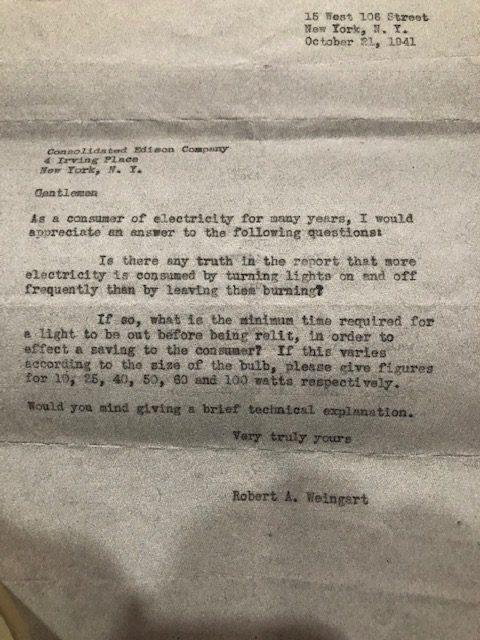Preserving a father’s letter about efficient light bulb use – and Con Ed’s prompt reply.
The evolution of efficient lighting and the search for safe and inexpensive illumination has been part of U.S. energy history since kerosene became a popular lamp fuel in the mid-19th century. Even earlier, illuminating gaslight manufactured from coal provided street lighting in Baltimore (1817), Philadelphia (1836), and other cities.
In September 1882, Thomas A. Edison began operating the first commercial U.S. power station in New York City. The coal-fired plant on Pearl Street powered six dynamos to provide electricity to homes in lower Manhattan. Four years later, six gas New York City companies merged into a giant utility, the Consolidated Gas Company.

Coal fueled Manhattan’s Pearl Street Station in 1882, the first U.S. electric power plant.
By 1920, Edison’s electric company had become a subsidiary of Consolidated Gas. With electric sales outpacing gas sales, Consolidated Gas changed its name to Consolidated Edison Company of New York in 1936 (see History of Con Edison). Five years later, John Weingart’s father Robert wrote the company seeking the best strategy for turning out lights to lower utility bills.
“I have a wonderful short 1941 correspondence from my father Robert asking the Consolidated Edison Company of New York whether you use more energy turning out lights when you leave a room if you know you’ll be back soon,” explained John Weingart in a November 2019 email to the American Oil & Gas Historical Society.
“I’d like to share it with others who might enjoy it,” Weingart added.
Incandescent light bulb Question
15 West 106 Street
New York, N.Y.
October 21, 1941
Consolidated Edison Company
4 Irving Place
New York, N.Y.
Gentlemen
As a consumer of electricity for many years, I would appreciate an answer to the following questions:
Is there any truth to the report that more electricity is consumed by turning lights on and off frequently than by leaving them burning?
If so, what is the minimum time required for a light to be out before being relit, in order to effect a saving to the consumer? If this varies according to the size of the bulb, please give figures for 10, 25, 40, 50, 60 and 100 watts respectively.
Would you mind giving a brief technical explanation.
Very truly yours
Robert A. Weingart

New Yorker Robert Weingart’s 1941 letter to the Con Edison.
Con Edison Customer Service in 1941
Weingart received a reply from the world’s largest electric utility the next day in a letter from Con Ed’s “Manager of the Sales Technical Bureau.”
CONSOLIDATED EDISON COMPANY OF NEW YORK, Inc.
4 IRVING PLACE
NEW YORK, N.Y.
October 22-1941
Mr. Robert A Weingart
15 West 106 Street
New York, N Y
Dear Sir
The belief that more electricity is consumed by turning electric lights on and off frequently than by leaving them burning has, from a practical point of view, no basis in fact.
An incandescent electric light consists essentially of a resistance, usually called a filament, surrounded by a glass bulb. The passage of an electric current through the filament causes it to heat to incandescence at which point it emits light. The function of the glass bulb is to prevent oxygen in the air from coming into contact with the filament in order to prevent the destruction of the filament by oxidation. The interior of the bulb is, in modern lamps, filled with an inert gas, such as nitrogen or argon. For a very small fraction of a second after an electric current is turned on to such a bulb, and until the filament is heated, more than normal current will pass through the filament. This is probably the basis for the belief expressed in your letter, but the increase in the amount of electricity consumed is so small that it could not be measured by ordinary metering apparatus and even the cumulative effect of a great many on and off operations could not be measured with ordinary metering equipment.
The operation of a fluorescent lamp is different in principle from that of an incandescent lamp but the same conclusion holds, that is, that there is no increase in electricity because of frequent turning on and off of the amp which could be measured with ordinary metering equipment. However, in the case of the fluorescent lamp the frequent turning on and off of the lamp is apt to shorten its life considerably through dissipation of the coating on the heating element and the lamp should be applied, therefore, to situations which require frequent starting and stopping, such as in flasher signs.
I trust that this is a satisfactory answer to your question.
Very truly yours,
J C Murtha, Manager
Sales Technical Bureau
JCM/hb

John Weingart rightly believes his father’s 1941 letter and the response should be remembered as part of U.S. energy history.
“One of the most striking thing about this correspondence remains, I think, that the question is still unresolved to many (maybe most ) lay people,” he concluded. “When I’ve mentioned this letter or shown it to friends, the first comment often is, ‘Yeah, I’ve wondered about that too.’ And, then the apparent detailed, informative response dated only one day after the initial letter of inquiry remains remarkable.”
_______________________
Recommended Reading: Greater Gotham: A History of New York City from 1898 to 1919 (2017);. Your Amazon purchase benefits the American Oil & Gas Historical Society. As an Amazon Associate, AOGHS earns a commission from qualifying purchases.
_______________________
The American Oil & Gas Historical Society preserves U.S. petroleum history. Join today as an annual AOGHS supporting member. Help maintain this energy education website and expand historical research. For more information, contact bawells@aoghs.org. Copyright © 2022 Bruce A. Wells. All rights reserved.
Citation Information – Article Title: “OA 1941 Letter to Consolidated Edison of N.Y.” Authors: B.A. Wells and K.L. Wells. Website Name: American Oil & Gas Historical Society. URL: https://aoghs.org/oil-almanac/a-1941-letter-to-con-ed-of-n-y. Last Updated: March 22, 2022. Original Published Date: January 18, 2019.

